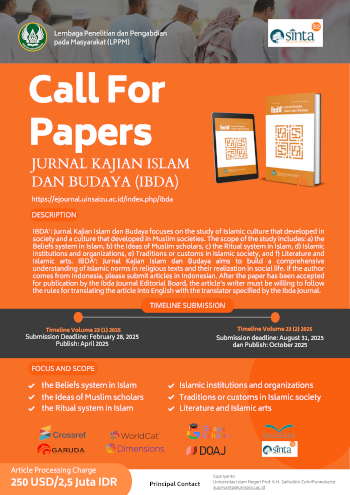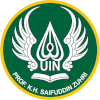Meaning and philosophy of Bale beleq traditional house East Lombok
DOI:
https://doi.org/10.24090/ibda.v21i2.7789Kata Kunci:
bale beleq, meaning, philosophy, traditional houseAbstrak
The Bale beleq traditional house of Jerowaru Village and Wakan Village is a historical heritage. This house is different from ordinary traditional houses because Bale beleq is occupied by people who are respected. In addition, there are also historical relics such as keris, swords, and many more. This research aims to examine information about the meaning and philosophy of the Bale beleq traditional house. This research was conducted in Jerowaru Village and Wakan Village. Eight respondents were interviewed. The research method used was the qualitative method. Data collection was done by using observation, interview, and documentation methods. The data analysis techniques are data collection, data reduction, data presentation, and conclusion drawing or verification. The results of the study found the history of the emergence of the Bale beleq traditional house, the meaning and philosophy of Bale beleq, and the values within Bale beleq. Currently, Bale beleq is used as a center for socio-cultural religious activities. One way to maintain and preserve traditional houses is to make the house a cultural heritage so that it does not erode with the time, and to make Bale beleq an educational and cultural tour site.Unduhan
Referensi
Abdulghani, T., & Sati, B. P. (2020). Pengenalan rumah adat Indonesia menggunakan teknologi augmented reality dengan metode marker based tracking sebagai media pembelajaran. Media Jurnal Informatika, 11(1), 43. https://doi.org/10.35194/mji.v11i1.770
Amalia, A. (2014). Karakteristik arsitektur rumah adat Wajo di Kompleks Miniatur Budaya Sulawesi Selatan Benteng Sombaopu Makassar. Teknosains: Media Informasi Sains dan Teknologi, 8(2), 227–240. https://doi.org/10.24252/teknosains.v8i2.1911
Anandy, R., Efrizal, E., & Erfahmi, E. (2016). Studi tentang bentuk dan penempatan ukiran rumah adat Bubungan Lima Bengkulu. Serupa: The Journal of Art Education, 4(3). https://doi.org/10.24036/sr.v4i3.8157
ASa, Z., Wikantaria, R., Mochsen Sira, M., Harisaha, A., & Radja, A. M. (2019). Makna filosofi spasial horizontal dan vertikal rumah tradisional Duri di Kabupaten Enrekang. Talenta Conference Series: Energy and Engineering (EE), 2(1), 262–270. https://doi.org/10.32734/ee.v2i1.414
Asadi, S., Fakhari, M., & Sendi, M. (2016). A study on the thermal behavior of traditional residential buildings: Rasoulian house case study. Journal of Building Engineering, 7, 334–342. https://doi.org/10.1016/j.jobe.2016.07.012
Attia, A. S. (2020). Traditional multi-story house (Tower House) in Sana’a City, Yemen. An example of sustainable architecture. Alexandria Engineering Journal, 59(1), 381–387. https://doi.org/10.1016/j.aej.2020.01.001
Baboli, F. B. M., Ibrahim, N., & Sharif, D. M. (2015). Design characteristics and adaptive role of the traditional courtyard houses in the moderate climate of Iran. Procedia - Social and Behavioral Sciences, 201, 213–223. https://doi.org/10.1016/j.sbspro.2015.08.170
Dalkılıç, N., & Nabikoğlu, A. (2020). Documentation and analysis of structural elements of traditional houses for conservation of cultural heritage in Siverek (Şanlıurfa, Turkey). Frontiers of Architectural Research, 9(2), 385–402. https://doi.org/10.1016/j.foar.2019.11.003
Elert, K., García Baños, E., Ibañez Velasco, A., & Bel-Anzué, P. (2021). Traditional roofing with sandstone slabs: Implications for the safeguarding of vernacular architecture. Journal of Building Engineering, 33, 101857. https://doi.org/10.1016/j.jobe.2020.101857
Eni, S. P. (2017). Pelestarian permukiman rumah tradisional Batak Toba di Desa Jangga Dolok, Sumatera Utara [Undergraduate thesis]. FakultasTeknik, Universitas Kristen Indonesia.
Gazquez, L. A. M., Hernández, F. F., & López, J. M. C. (2022). A Comparison of traditional and contemporary social houses in Catarmarca (Argentina). Comfort conditions and life cycle assessment. Sustainable Cities and Society, 82, 103891. https://doi.org/10.1016/j.scs.2022.103891
Irianti, F., Dewi A., M. A., & Surya A., C. S. (2022). Kajian etnomatematika rumah adat Gadang Suku Minangkabau. Prisma: Prosiding Seminar Nasional Matematika. https://journal.unnes.ac.id/sju/index.php/prisma/article/view/54275
Juliani, J., Juliana, J., Komalasari, F. D., Hamdani, H., Umar, H., Suryani, I., Nursaptini, N., & Tahir, M. (2020). Nilai kearifan lokal dalam rumah adat Limbungan Suku Sasak. Jurnal Dinamika Sosial Budaya, 22(2), 158–164. https://doi.org/10.26623/jdsb.v22i2.2832
Julita, I., & Hidayatun, M. I. (2020). Perubahan fungsi, bentuk dan material rumah adat Sasak karena modernisasi. Atrium: Jurnal Arsitektur, 5(2), 105–112. https://doi.org/10.21460/atrium.v5i2.90
Kawer, O. F. S., Baiquni, M., Keban, Y. T., & Subarsono, A. (2018). Implementasi kebijakan pembangunan rumah layak huni dengan pendekatan hibrida di Kabupaten Supiori Provinsi Papua. Sosiohumaniora, 20(3), 245–253. https://doi.org/10.24198/sosiohumaniora.v20i3.18489
Mar, A., Mamoh, O., & Amsikan, S. (2021). Eksplorasi etnomatematika pada rumah adat Manunis Ka’umnais Suku Uim Bibuika Kecamatan Botin Leobele Kabupaten Malaka. Jurnal MathEdu (Mathematic Education Journal), 4(2), 155–162. https://doi.org/10.37081/mathedu.v4i2.2446
Nurjaman, A., Rusmana, D., & Witro, D. (2021). Filosofi dan nilai-nilai Islam dalam gaya bangunan rumah adat Kampung Naga Tasikmalaya: Sebuah analisis terhadap rumah adat dengan pendekatan studi Islam. Jurnal Penelitian Sejarah dan Budaya, 7(2), 227–250. https://doi.org/10.36424/jpsb.v7i2.258
Saad, H., Abdullah, A. S. N., Azni, M. E., Yaacob, Z., Ghazali, M. S., Zahari, M. N., Mahmud, M. N., & Hakim, A. B. A. (2019). Typology of Malay traditional house and its response to the thermal environment. Materials Today: Proceedings, 19, 1761–1770. https://doi.org/10.1016/j.matpr.2019.11.214
Safitri, B. I. D., & Priscilla, B. C. (2022). Analisis aspek Matematika dalam rumah adat Bajawa Nusa Tenggara Timur. Prisma: Prosiding Seminar Nasional Matematika. https://journal.unnes.ac.id/sju/index.php/prisma/article/view/54570
Saragih, H. A., Lubis, F., & Jamil, K. (2021). Sejarah peninggalan rumah adat Bolon di Desa Pematang Purba, Kabupaten Simalungun. Warisan: Journal of History and Cultural Heritage, 1(3), 88–93. https://doi.org/10.34007/warisan.v1i3.577
Sari, F. D., Pratama, H. N., & Setiawan, I. (2020). Identifikasi umah adat Pitu Ruang sebagai produk kebudayaan Gayo. Studi kasus: Umah Reje Baluntara di Aceh Tengah. Gorga: Jurnal Seni Rupa, 9(2), 451–454. https://doi.org/10.24114/gr.v9i2.22116
Sharon, S. S., & Paranoan, S. (2020). Refleksi rumah adat Ammatoa dalam akuntabilitas organisasi. Jurnal Akuntansi Multiparadigma, 11(1), 59–76. https://doi.org/10.21776/ub.jamal.2020.11.1.04
Sudriamunawar, H., Januarharyono, Y., Fauziyah, R., & Ningsih, M. Y. (2020). Strategi pengembangan wisata rumah adat di Kabupaten Bandung. Jurnal Ilmiah Magister Ilmu Administrasi, 14(1). https://jurnal.unnur.ac.id/index.php/jimia/article/view/353
Sugiyono. (2018). Metode penelitian kuantitatif. Alfabeta.
Sutiari, N. K., Darma Putra, I. K. G., & Sunia Raharja, I. M. (2018). Aplikasi pengenalan rumah adat Indonesia berbasis Augmented Reality. Jurnal Ilmiah Merpati (Menara Penelitian Akademika Teknologi Informasi), 6(2), 108–118. https://doi.org/10.24843/JIM.2018.v06.i02.p05
Udju, A. A. H., & Saingo, Y. A. (2022). Filosofi bangunan rumah adat komunitas Sabu (Ammu ae nga rukoko do hawu). Studi pedagogis di Sabu – Desa Ledeana Kecamatan Sabu Barat, Kabupaten Sabu Raijua, tahun 2021. Jurnal Patra, 4(2), 82–90. https://doi.org/10.35886/patra.v4i2.316
Wahidin, R. (2019). Aplikasi pengenalan rumah adat Indonesia menggunakan Augmented Relity. JATI: Jurnal Mahasiswa Teknik Informatika, 3(1), 263–268. https://doi.org/10.36040/jati.v3i1.641
Wibowo, A. P. (2021). Pemodernan atap rumah tradisional Jawa sebagai upaya pelestarian kearifan lokal. Sinektika: Jurnal Arsitektur, 18(2), 141–147. https://doi.org/10.23917/sinektika.v18i2.12323
Ziraluo, M., Fau, H. S., Simanullang, N. R., Laia, B., & Gaurifa, D. (2022). Filosofi dan makna Omo Sebua (rumah adat besar) di Desa Bawomataluo Kecamatan Fanayama Kabupaten Nias Selatan. Jurnal Pendidikan Ekonomi, 3(2). https://jurnal.uniraya.ac.id/index.php/JPE/article/view/465
Zulfikar, F. (2020). Kearifan lokal dalam arsitektur rumah adat Osing sebagai sumber pembelajaran IPS. Jurnal Pendidikan Sejarah Indonesia, 3(1), 43–51. https://doi.org/10.17977/um0330v3i1p43-51
Unduhan
Diterbitkan
Cara Mengutip
Terbitan
Bagian
Lisensi
Hak Cipta (c) 2023 Elmi Septiana; Ahmad Afandi; Ilmiawan Ilmiawan, Agus Herianto

Artikel ini berlisensiCreative Commons Attribution-ShareAlike 4.0 International License.
Authors who publish with this journal agree to the following terms:
- Authors retain copyright and grant the journal right of first publication with the work simultaneously licensed under a Creative Commons Attribution-ShareAlike License a that allows others to share the work with an acknowledgement of the work's authorship and initial publication in this journal.
- Authors are able to enter into separate, additional contractual arrangements for the non-exclusive distribution of the journal's published version of the work (e.g., post it to an institutional repository or publish it in a book), with an acknowledgment of its initial publication in this journal.
- Authors are permitted and encouraged to post their work online (e.g., in institutional repositories or on their website) before and during the submission process, as it can lead to productive exchanges, as well as earlier and greater citation of published work (See The Effect of Open Access).















